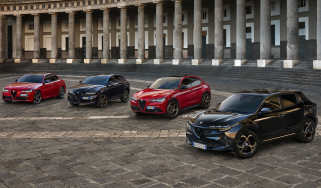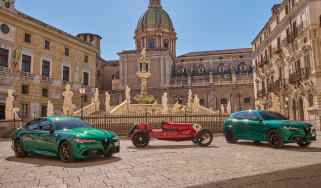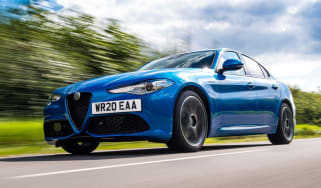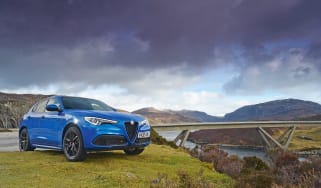Alfa Romeo Stelvio review
The handsome Alfa Romeo Stelvio is a sporty SUV that's good to drive, but it's expensive to buy and run compared to some rivals
The Stelvio inherits perhaps the most important quality of any Alfa Romeo: uniquely desirable styling that stands out in the SUV crowd. The interior is similarly attractive to the eye, even if the Germans still have it beaten for fit and finish and rear seat space.
The sporty Italian SUV follows in the footsteps of the excellent Giulia saloon; great to drive, with strong engines and handling that's agile and involving, although the ride isn't as comfortable as its best rivals. Overall, the Alfa Romeo Stelvio is definitely worth a look if you're bored of the German establishment – it's got style and flair in spades, but it remains expensive to buy and some rivals boast superior residual values.
About the Alfa Romeo Stelvio
These days, a car company can't just rely on its heritage and character to earn sales, the big bucks are in the business of meeting customer demand. So really it's no surprise that the Alfa Romeo Stelvio, the company's first SUV, exists. Alfa clearly saw the money to be made in the mid-sized premium SUV class and decided it needed to put one on sale.
Under the skin, the Stelvio shares a platform with the Giulia saloon, and is part of the revival the brand is currently in the middle of to make it a viable alternative to the Germanic norm. As a result, the new platform is designed to deliver comfort and engaging handling, there are a range of powerful yet efficient petrol and diesel engines, while a high-performance model signals Alfa's intent on delivering cars that are fun for enthusiasts to drive.
The Stelvio is a rival to models such as the Jaguar F-Pace and Volvo XC60, along with the German trio of the Audi Q5, BMW X3 and Mercedes GLC. Other opponents include the Land Rover Discovery Sport and Lexus NX, while faster Stelvio models could be considered as an alternative to performance SUVs such as the Porsche Macan and Alpina XD3, or even a more left-field choice such as the Cupra Formentor.
The model range comprises of Sprint, Veloce and Competizione trims, while at the top is the Quadrifoglio version. All cars come in a standard five-door SUV body, although it's curvy enough that the lack of coupe-SUV in the line-up isn't an issue. All-wheel drive and an eight-speed automatic gearbox are standard on all UK cars.
There are two engines available in the regular Stelvio: a 2.0-litre turbo petrol that produces 276bhp, and a 2.2-litre diesel that pumps out 207bhp. Both engines are offered in all three trim levels. At the top of the range, the 503bhp Stelvio Quadrifoglio features the same Ferrari-engineered 2.9-litre twin-turbo V6 as the Giulia, but as it comes with four-wheel drive, its total traction means it's faster from 0-62mph by a tenth of a second at 3.8 seconds.
Prices for the Stelvio range from around £47,000 to nearly £80,000 for the Quadrifoglio. Standard kit on all models now includes a 12.3-inch digital dash with three different layouts, a 8.8-inch central touchscreen, Apple CarPlay, Android Auto, Alfa Romeo’s DNA drive-mode selector and aluminium shift paddles on the steering wheel. Competizione spec models also get 21-inch alloy wheels, red brake calipers, an exclusive matte grey paint and Alfa Romeo’s Active Suspension system, which incorporates electronically controlled dampers.
Engines, performance and drive
Underneath the Alfa’s jacked-up, swooping body is a modified version of the Giorgio platform that underpins the Italian brand’s Giulia compact executive saloon.
For a mainstream SUV the Stelvio boasts some advanced engineering that you might not be able to see, but, Alfa hopes, you will be able to feel. The first is a carbon fibre propshaft, which combined with a number of other measures – such as aluminium suspension components – helps keep weight down.
Those aluminium components are part of the double-wishbone front suspension system, while at the rear there’s a multi-link axle. This set-up gives the Stelvio a dynamic edge over most of its rivals, and it all means that the Stelvio is huge fun to drive for an SUV.
Compared with the Giulia, the Stelvio has been raised by 22cm to help give it a proper SUV stance, while Alfa’s Q4 four-wheel drive system is standard. An eight-speed automatic gearbox is standard across the range.
This might be a jacked-up SUV, but what strikes you first out on the road is the speed and response of the car’s steering. It’s becoming an Alfa trademark, and despite the Stelvio’s size you become accustomed to how fast it turns in. The steering is quick, and there’s enough grip that the chassis can cope with it, but until you get used to it, it does make it feel a little nervous and not so relaxed.
It’s an agile SUV, but the trade-off is that the car feels jittery due to its more focused set-up. The ride isn’t as refined as either a Volvo XC60's or Mercedes GLC's, with an unsettled feeling over bumpy surfaces regardless of speed, although the more you push the chassis the better the dampers respond, showing the Stelvio’s impressive body control.
Alfa insists that, like the Macan and F-Pace, the Stelvio is a road-based SUV – it does without the kind of off-road driving modes you’d find on a Land Rover Discovery Sport, although there is a downhill descent system fitted, should the need arise.
0-62mph acceleration and top speed
As part of the Stelvio's facelift for 2023, the engine line-up was reduced to a 2.0-litre, four-cylinder turbocharged petrol unit producing 276bhp, a 207bhp 2.2-litre diesel and the fire-breathing 503bhp 2.9-litre bi-turbo V6 engine you can only get in the Stelvio Quadrifoglio.
The 276bhp petrol is a very punchy powertrain, offering up a broad spread of power felt from just over 2,000rpm and taking the SUV from 0-62mph in 5.7 seconds. It's smooth and flexible, but it's a pity the engine note is barely any more inspiring than the diesel's, as having sweet-sounding petrol engines was historically an Alfa trait.
The Quadrifoglio is likely to be a rare but interesting sight on British roads, but you can rest assured that anyone driving one will be having a great time. Just as in its Giulia counterpart, the V6 and eight-speed auto make an excellent paring: the wide spread of torque, sharp throttle response and thumping gear changes make it one of the best powertrains in the business and will propel you from 0-62mph in 3.8 seconds. It’s clever,too, as it can shut down a bank of its cylinders without detection to reduce fuel consumption when cruising at steady speeds of up to around 80mph.
You can't fail to notice the brutal acceleration, but after that you notice the steering, which is super-sharp and accurate; the slightest twitch from your wrist is transmitted directly to the wheels. It instils the Stelvio with a greater sense of agility than its kerbweight would lead you to believe possible. Combined with the four-wheel drive system, it makes for an incredibly fast and secure performance car.
Flick through the various drive modes up to the most aggressive Race setting, and the reins are loosened on the stability control. This allows for a bit more movement at the rear end before the four-wheel drive system gathers it all up and launches you down the road, but even here it’s incredibly surefooted.
This is all well and good, but it’s the diesel that might still tempt buyers in the real world. The 2.2-litre unit has been used in a variety of Fiat Group cars, most notably the Alfa Giulia saloon (although now discontinued), and it’s our choice of the mainstream crop. With 470Nm of torque, it pulls sweetly and allows the Stelvio diesel to hit 62mph in 6.6 seconds. It’s helped by the smooth auto box when left to its own devices, however, engaging manual mode using the shift paddles makes changes jerkier.
All cars come with a ZF eight-speed automatic gearbox – the same type BMW uses in the X3 and Jaguar in the F-Pace. It’s a good combination with the engines we’ve tried and delivers quick and sharp gear changes. The aluminium paddles on the steering column add a level of tactility lacking in the Stelvio’s rivals – those cars tend to use flimsier plastic paddles. If you're a keen driver who likes to take control, it's a touch you'll appreciate.
Engine refinement in the diesel is okay, but it’s a little noisy on the move, with a typical diesel grumble evident in the cabin if you rev the motor hard. There’s more wind noise, too, compared with some rivals.
MPG, CO2 and running costs
Although the Stelvio doesn't feature any form of hybrid technology, Alfa's efforts to keep the extra pounds at bay has helped its premium SUV return decent fuel consumption figures and reasonably competitive levels of CO2.
There are just two engines to choose from: a 207bhp diesel and 276bhp petrol. Alfa claims the oil-burner will deliver an average of 47.1mpg while emitting 162g/km of CO2. For comparison, the Audi Q5 40 TDI is capable of 44.8mpg at best, with CO2 emissions from 164g/km.
The petrols naturally fare less well. According to Alfa, it's capable of returning 33.6mpg at best and CO2 emissions start from 191g/km, however, when we tested this particular version of the Stelvio it only managed to achieve 24.4mpg.
Unsurprisingly, the Stelvio Quadrifoglio, with its 503bhp 2.9-litre V6 petrol engine, will be even less frugal and the most costly to tax, too – but it should be comparable to a Porsche Macan GTS and the Mercedes-AMG GLC 63 S.
Insurance
The 207bhp diesel sits in insurance groups 34-35, depending on what specification you go for, while the 276bhp petrol model sits in groups 37 regardless of the specification. The 503bhp Stelvio Quadrifoglio will be the most expensive variant to insure, as sits in group 50 out of 50.
Check your tax status and renewal date in seconds. Check your VED car tax now
Depreciation
The Stelvio should hold onto around 50 per cent of its original list price after a typical three-year/36,000-mile ownership period, with the diesel versions performing a touch better at around 51-52 per cent.
To get an accurate valuation on a specific model check out our Free Car Valuation tool
Interior, design and technology
Alfa Romeo treated the Stelvio to a facelift in late 2022, as well as boost in technology and a revised trim structure. The already very handsome Stelvio now features the 3x3 headlight signature first seen on the smaller Tonale SUV, which also pays homage to the iconic SZ Zagato from the early 90s. The distinctive triangular ‘Trilobo’ grille has also been given a new paint finish and there's some extra gloss black trim on the exterior, but that's about it for the styling changes.
One of the more noticeably changes can be found inside. The Stelvio is now equipped as standard with a 12.3-inch digital driver's display with three distinct layouts: 'Evolved’ is the more conventional readout, ‘Relax’ provides minimal information, and ‘Heritage’ adds a bit of retro style. We have no doubt some will miss the analogue dials you got in the Stelvio until now, but we found the new digital dash to be a welcome improvement.
The Stelvio does still feature an array of physical buttons, which is reassuring in a time of enormous, complicated touchscreens and touch-sensitive panels. However, despite other improvements to the Stelvio's cabin and on-board technology over the years, it still can't quite stand up to its established German competition in terms of tech and perceived quality.
Entry-level Sprint models come with faux leather and cloth upholstery as standard, while Veloce and Competizione spec cars get sports leather seats in either black or red. Alloy wheel sizes also vary between trim levels, with base models riding on 19-inch rims and top-spec models getting 21-inch versions of Alfa's iconic five-hole wheels.
Sat-nav, stereo and infotainment
Alfa’s 8.8-inch infotainment has been gently improved over time, and in isolation is a decent-enough system. But against its rivals, its shortcomings are highlighted. The display itself is neatly integrated into the dash, but the screen is quite small. The graphics are also a little on the dull side and the screen just doesn’t have the clarity or level of detail you get in rival systems.
While the touchscreen reacts well enough to inputs, a huge bonus is that this system can also be operated
via a swivel wheel on the centre console; it makes using the set-up while driving a lot easier and safer.
We did find Alfa’s infotainment pretty straightforward to use, but we expect most people will just use the standard-fit Apple CarPlay or Android Auto smartphone connectivity. A wireless phone charging pad also features on Veloce versions.
Practicality, comfort and boot space
Most cars in this class carry two occupants with the rear seats used to occasionally carry children. The good news is that the Stelvio offers a decent amount of space inside, and even matches its less style-driven SUV rivals.
Up front, it's reasonably spacious: there’s a good amount of headroom even for six-footers and visibility is fine thanks to thin-ish pillars. The Alfa doesn't offer the more rear passenger space in this class, but average-sized adults will find enough comfort to make this a useable family buy, even if do they sit a little upright. The boot is comparable with rivals too, thanks to a flat, long load space, but it could be wider.
For storage, the Stelvio scores pretty highly. There are large door pockets for water bottles and other oddments, as well as a couple of cupholders ahead of the gearlever, along with a USB charging port. The glovebox is of a decent size, as is the space under the centre armrest. However, flipping the lids on the various trays and cubbies highlights some of the Alfa’s not-so-premium-quality materials, especially next to the plush-feeling Mercedes GLC.
Dimensions and size
Measuring 4,687mm from nose to tail, the Stelvio is one of the longest cars in the class – the Audi Q5, BMW X3 and Mercedes GLC are all slightly shorter, with only the F-Pace being marginally longer than the Alfa. At 1,903mm wide, the Stelvio is also slightly wider than its German rivals, but it isn't as tall as many of them, giving it a more athletic stance.
Leg room, head room and passenger space
Interior space is pretty good for a sporty SUV: it’s acceptable for the class rather than exceeding rivals, but given the sporting focus of the Stelvio, it’s hard to argue with that. Stick four six-footers inside the Alfa and the two rear passengers would have their knees brushing the backs of the front seats a little. Headroom is merely okay, but that’s due to the sloping roof design.
Due to the Stelvio being positioned away from the family-oriented market there are no clever rear seats. They don’t slide or recline to allow more space, although you can fold them down in a 40:20:40 split to load longer items.
Boot space
Once again, the Stelvio sits in the middle of the pack when compared to its rivals. The Stelvio’s hatch slopes more heavily at the rear than some rivals, plus the roofline is lower, too. Boot space stands at 525 litres, which is 20 litres more than the Volvo XC60, but a long way off the roughly 600 litres you get in the Mercedes GLC. Dropping the Stelvio's rear bench increases the space to 1,600 litres.
The standard-fit electric tailgate reveals a usefully long, flat loading space, although it could be wider as the rear suspension takes up space over the wheelarches. There’s no lip when the seats are folded and there’s no step to lug items over, though. Sadly, there are no thoughtful touches like underfloor storage, hooks or netting to store loose or bulky items.
Reliability and safety
Like its Giulia sibling, with which it shares key components, construction and safety features, the Stelvio was awarded Euro NCAP maximum five-star crash safety rating when it was tested in 2017. The sporty Italian SUV also achieved a very impressive 97 per cent score for adult occupant safety and 84 per cent for child passenger protection.
Standard safety kit is good too, as every Stelvio comes equipped with front and rear parking sensors, a rear-view camera, active cruise control, Autonomous Emergency Braking (AEB) and Lane Departure Warning. For an extra £1,000, you can add the Driver Assistance Pack to any Stelvio, which includes Drowsy Driver Alert, Traffic Sign Recognition (TSR), Lane Keep Assist, Traffic Jam Assist and Highway Assist which combines active cruise control and lane centering technology for semi-autonomous highway driving.
The Stelvio didn't feature in our latest Driver Power owner satisfaction survey, although the closely related Giulia saloon has enjoyed success in the best cars to own rankings in recent years.
Warranty
Every Alfa Romeo now comes with a with a three-year/unlimited mileage warranty, with the opportunity to extend the Stelvio's cover for a further 12 or 24 months at extra cost. A year's roadside assistance is also included.
Servicing
Buyers can opt for one of Alfa's tailored service plans that relate to how you use your car and how many miles you cover over a 12 month period.
More reviews
Car group tests
In-depth reviews
Road tests
Used car tests
Which Is Best
Cheapest
- Name2.2 D 210 Sprint 5dr AWD Auto
- Gearbox typeSemi-auto
- RRP£47,320
Most Economical
- Name2.2 D 210 Sprint 5dr AWD Auto
- Gearbox typeSemi-auto
- RRP£47,320
Fastest
- Name2.9 V6 BiTurbo Quadrifoglio 5dr Auto
- Gearbox typeSemi-auto
- RRP£93,745

























